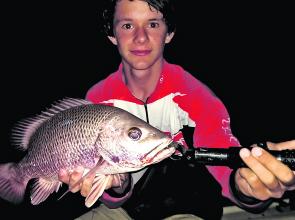One thing that excites many South-East Queensland anglers is the warmer season fishing - a time when the mangrove jacks become a lot more active throughout the various estuaries.
Jacks are one of the most sought-after fish in these estuaries; they fight hard, even the smaller ones, and readily take baits and well-presented lures. Sometimes it may take some persistence in order to catch these fish, but it does pay off!
When looking for a good location to target these fish, anywhere with a good amount of structure in the water will most likely hold a jack. This can be mangrove systems, rocky patches and rock bars, bridge pylons, fallen trees, jetties or moored boats. Look for eddies that have formed due to water movement on the down-current side of structure, which looks like a ‘flat spot’ on the water. Jack will most often sit in these areas as they are able to sit and wait for vulnerable bait to swim past. Also, like always, fish where there is bait present as predatory fish are always on the lookout. Where there is bait it is always worth a shot casting around the area. At the moment there are jacks being caught all throughout the Noosa River amongst the various artificial and natural structures. When targeting most species of fish, it comes down to what you’re using and how you’re targeting them, and where and when.
I prefer targeting jacks with lures as I feel it’s much more rewarding ‘hunting’ the fish, instead of sitting and waiting for them to take the bait. I love the moment when you’re slowly working the lure out of structure and then all of a sudden, BANG! A hit that is characteristically a jack. However, it’s still fun no matter how or what you use to target jacks. Outfits that you’d use to target these fish must be of good quality, a reel with a good drag system and a rod that loads up nicely when put under pressure. A rod that would be most suitable for targeting these fish is something in the range of 8-15lb, with a reel to suit, either spinning or bait cast. Use braided lines of around 10–20lb, with leaders within the same range. Obviously the breaking strain of the line you’re using will depend on where and what kind of structure you’re fishing, this is just a guide. Bait-wise, live herring or mullet are the most effective. Most of the time, a small ‘pea’ sinker and a 3/0 suicide hook is all that is needed when using these live baits. The small weight will allow it to swim freely, which is definitely a lot more natural to a predatory fish.
If you’re into using lures, jacks will take a variety of plastics and hard bodies. At the moment, prawn imitation lures have been working the most effectively. These include Zerek Prawns, Ecooda Live Prawns and Gladiator Prawns. Letting the prawn lure sink alongside, or when rigged weedless, inside the structure, then applying sharp twitches of the rod tip is a good approach. Hard bodies including Jackall Squirrels, Atomic Shiners and Maria divers are good options for these fish. Any sort of gold colour on these hard bodies has been found to work the best. Use a slow roll technique alongside structure, but make sure you’re not working the lure too fast in order to keep it in the strike zone for a longer period of time. Another way to target jack is using surface lures. This is a very exciting way to fish for them as they hit the surface extremely hard, almost crunching your lure. Use a surface popper like the Jackall SK Pop Grande which puts out a lot of sound when the action is put into it, annoying the jack enough to come up and whack it! Remember, surface fishing is always better toward the times of dusk and dawn. Position the boat parallel to the bank and then cast your lure alongside the structure. This will allow your lure to cover more ground and increasing your chances of hooking a jack. I prefer to fish for jack in the early mornings or late afternoons, and toward the turn of the top of the tide, before it begins to flow back out. However, on low tides, jacks may sometimes move out of shallow structure into deeper sections of water, so it is definitely worth it fishing the deeper holes within the local estuaries.
If you’re hooked onto one of these fish, especially of the larger specimens, it is key to just take your time in fighting the fish, and don’t rush. Eventually the fish will tire, if it hasn’t already busted you off, and you will be able to start winding line back, letting the fish run when it wants to. Once you’ve landed the jack, while being careful of its extremely sharp teeth, practice catch and release. These fish look great in photos, take a few nice shots, and then release it back into the water. Helping to sustain the population of these fish is vital.
Mangrove jack fishing can, at times be very exhilarating. It is always good to have good quality gear and tackle with you when going out to target these fish. Line and leaders, and also your knots, must be fairly strong, as they are the vital link between you and the fish. Remember these tips when fishing for them, and you will increase your chance of catching them. If you’re fishing the Noosa area, drop into Hooked on Angling and Outdoors in Tewantin, and the team will give you the best advice on how to target this great species!
Reads: 5214
The best thing about catching a jack is taking some nice shots, and then releasing it back into the water.




